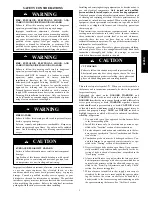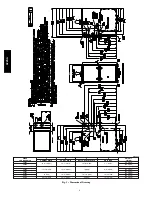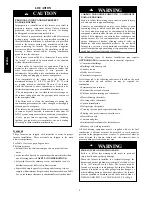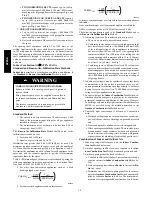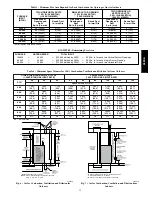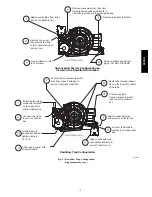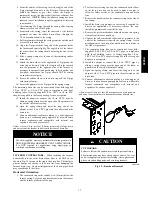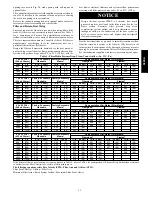
9
FIRE HAZARD
Failure to follow this warning could result in personal
injury, death and/or property damage.
Do not install the furnace on its back or hang furnace with
control compartment facing downward. Safety control
operation will be adversely affected. Never connect
return--air ducts to the back of the furnace. See Fig. 4.
!
WARNING
Location Relative to Cooling Equipment
The cooling coil must be installed parallel with, or on the
downstream side of the unit to avoid condensation in the heat
exchangers. When installed parallel with the furnace, dampers or
other flow control must prevent chilled air from entering the
furnace. If the dampers are manually operated, they must be
equipped with means to prevent operation of either unit unless the
damper is in the full--heat or full--cool position.
FURNACE RELIABILITY HAZARD
Failure to follow this caution may result in nuisance limit
switch cycling and unit component damage.
When a 17--1/2--in. wide upflow N coil is used with a
42060 furnace, the N coil must either be raised using a
transition piece at least 3--in. (76 mm) high or if a transition
piece is not used, the refrigerant lines must point to the front
of the furnace casing.
CAUTION
!
AIR FOR COMBUSTION AND
VENTILATION
Introduction
Direct Vent (2--pipe) Applications
When the furnace is installed as a direct vent (2-pipe) furnace, no
special provisions for air for combustion are required. However,
other gas appliances installed in the space with the furnace may
require outside air for combustion. Follow the guidelines below to
insure that other gas appliances have sufficient air for combustion.
Non--Direct Vent (1--pipe) Applications
When the furnace is installed as a non-direct vent (1-pipe) furnace,
it will be necessary to insure there is adequate air for combustion.
Other gas appliances installed with the furnace may also require air
for combustion and ventilation in addition to the amount of
combustion air and ventilation air required for the furnace. Follow
the guidelines below to insure that the furnace and other gas
appliances have sufficient air for combustion.
Ventilated Combustion Air Applications
When the furnace is installed using the ventilated combustion air
option, the attic or crawlspace must freely communicate with the
outdoor to provide sufficient air for combustion. The combustion
air pipe cannot be terminated in attics or crawlspaces that use
ventilation fans designed to operate during the heating season. If
ventilation fans are present in these areas, the combustion air pipe
must terminate outdoors as a Direct Vent/ 2-Pipe system.
All air for combustion is piped directly to the furnace from a space
that is well ventilated with outdoor air (such as an attic, crawl space
or equipment closet) and the space is well isolated from the living
space or garage. In addition, other gas appliances installed in the
space with the furnace may require outside air for combustion.
Follow the guidelines below to insure that the roof or crawlspace
walls have sufficient free area to provide sufficient air for
combustion and ventilation for the furnaces. The guidelines below
can be used to insure that other gas appliances have sufficient air
for combustion.
Provisions for adequate combustion, ventilation, and dilution air
must be provided in accordance with:
S
U.S.A. Installations: Section 9.3 of the current edition of NFPA
54/ANSI Z223.1 , Air for Combustion and Ventilation and
applicable provisions of the local building codes.
S
Canada: Part 8 of the current edition of CAN/CSA--B149.1,
Venting Systems and Air Supply for Appliances.
FURNACE CORROSION HAZARD
Failure to follow this caution may result in furnace damage.
Air for combustion must not be contaminated by halogen
compounds, which include fluoride, chloride, bromide, and
iodide. These elements can corrode heat exchangers and
shorten furnace life. Air contaminants are found in aerosol
sprays, detergents, bleaches, cleaning solvents, salts, air
fresheners, and other household products.
CAUTION
!
CARBON MONOXIDE POISONING HAZARD
Failure to follow this warning could result in personal
injury or death.
The operation of exhaust fans, kitchen ventilation fans,
clothes dryers, attic exhaust fans or fireplaces could create a
NEGATIVE PRESSURE CONDITION at the furnace.
Make--up air MUST be provided for the ventilation devices,
in addition to that required by the furnace. Refer to the
Carbon Monoxide Poisoning Hazard warning in the venting
section of these instructions to determine if an adequate
amount of make--up air is available.
!
WARNING
The requirements for combustion and ventilation air depend upon
whether or not the furnace is located in a space having a volume of
at least 50 cubic feet per 1,000 Btuh input rating for all gas
appliances installed in the space.
S
Spaces having less than 50 cubic feet per 1,000 Btuh (4.8 cubic
meters per kW) require the
Outdoor Combustion Air Method
.
S
Spaces having at least 50 cubic feet per 1,000 Btuh (4.8 cubic
meters per kW) may use the
Indoor Combustion Air,
Standard or Known Air Infiltration Method.
Outdoor Combustion Air Method
1. Provide the space with sufficient air for proper combustion,
ventilation, and dilution of flue gases using permanent hori-
zontal or vertical duct(s) or opening(s) directly communicat-
ing with the outdoors or spaces that freely communicate
with the outdoors.
2. Fig. 6 illustrates how to provide
TWO OUTDOOR
OPENINGS
, one inlet and one outlet combustion and vent-
ilation air opening, to the outdoors.
a. One opening
MUST
commence within 12 in. (300 mm)
of the ceiling and the second opening MUST commence
within 12 in. (300 mm) of the floor.
b. Size openings and ducts per Fig. 6 and Table 3.
922SA



